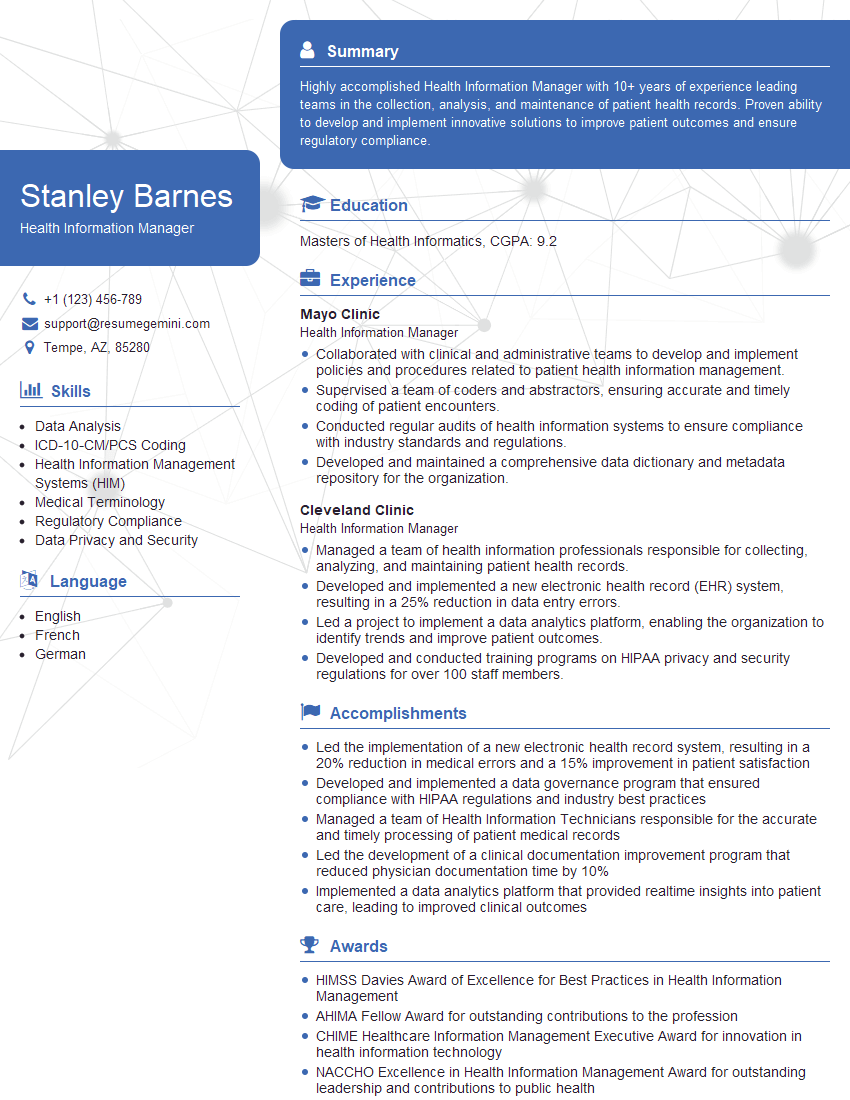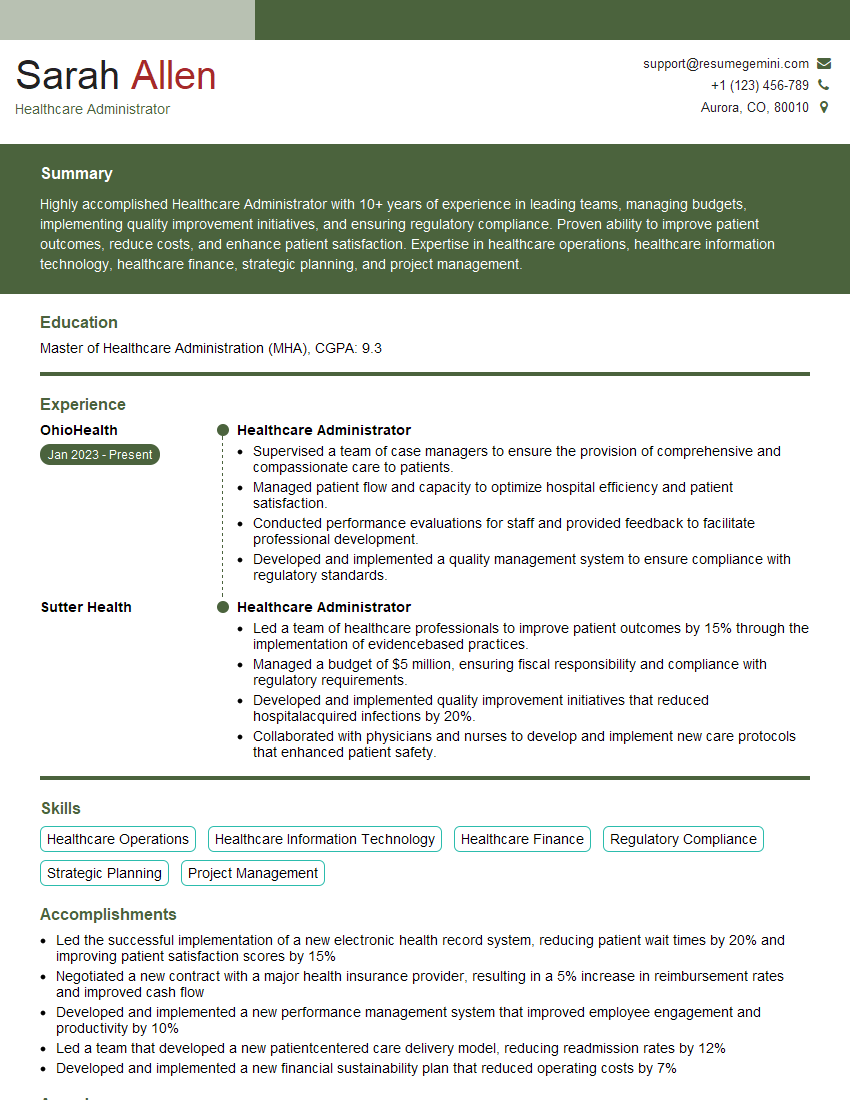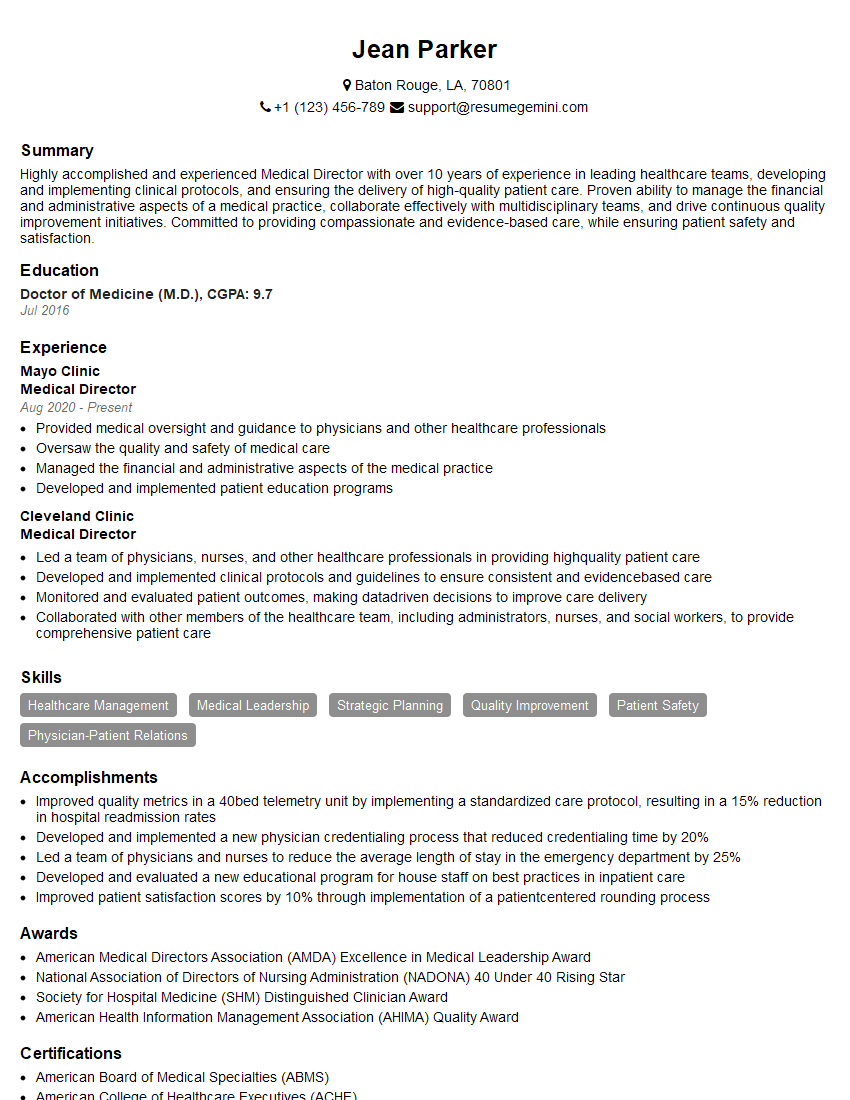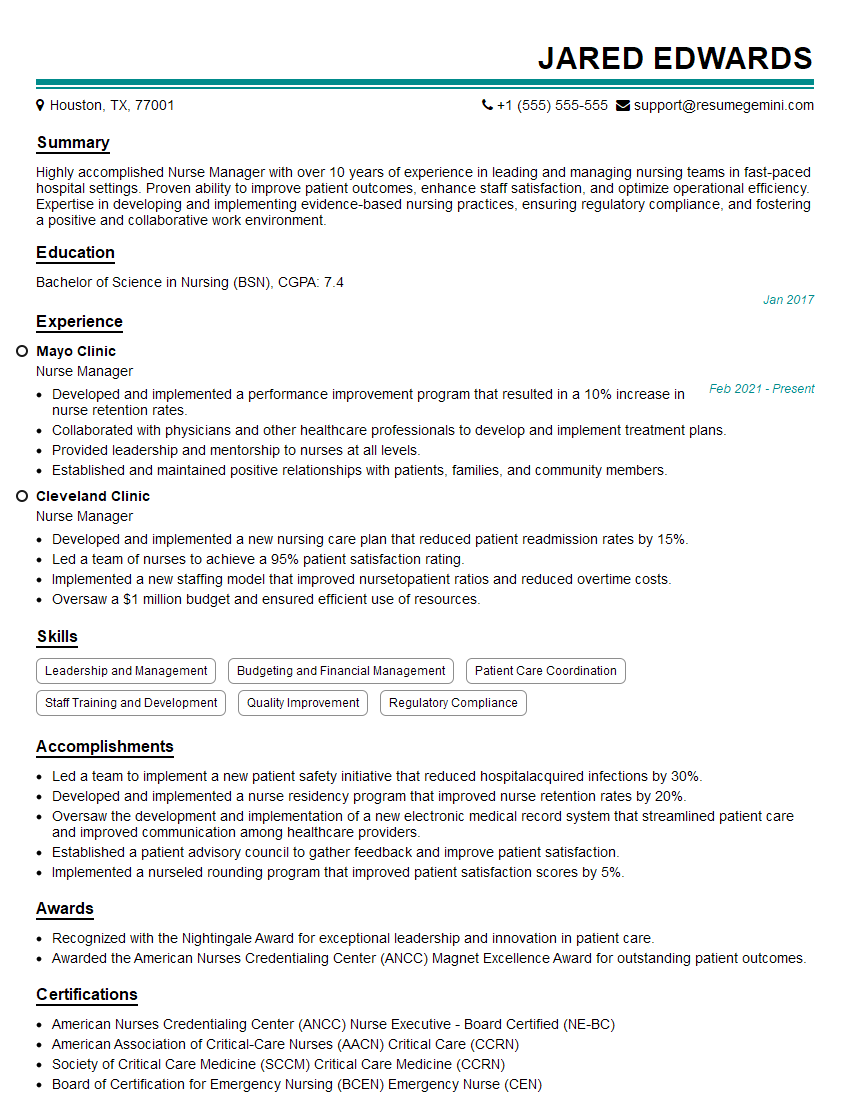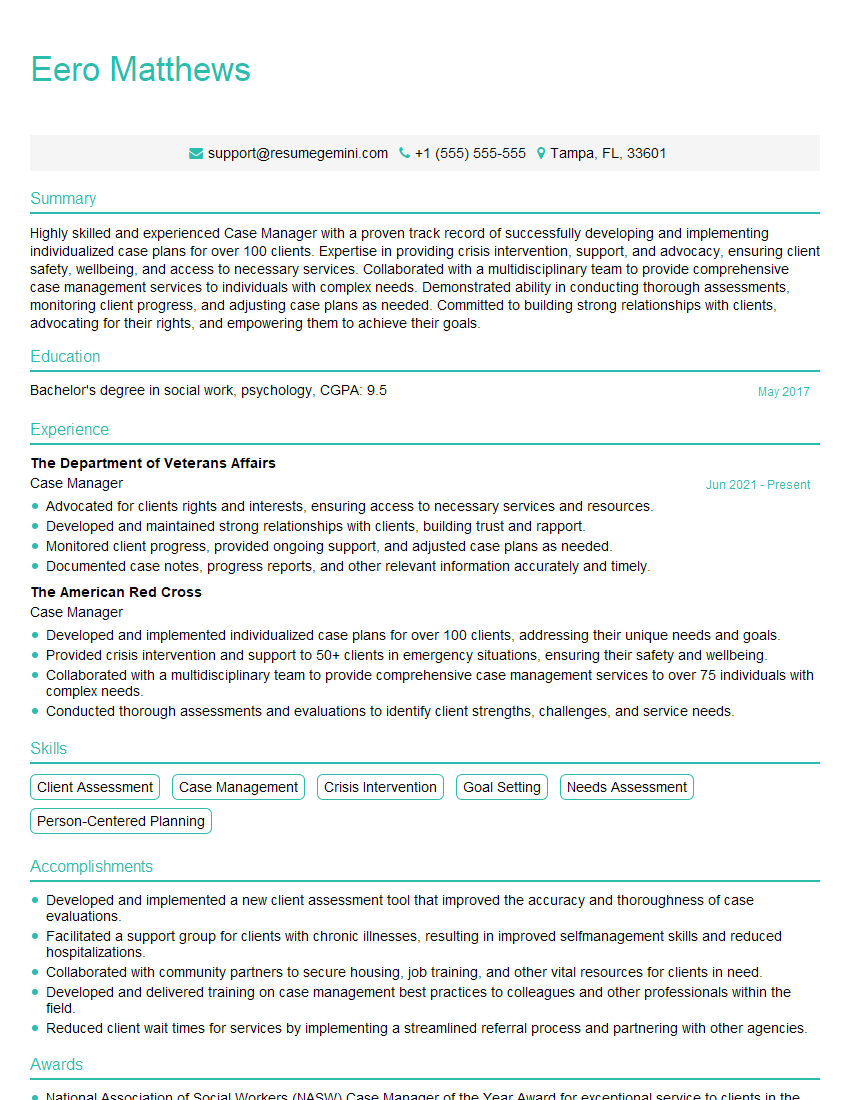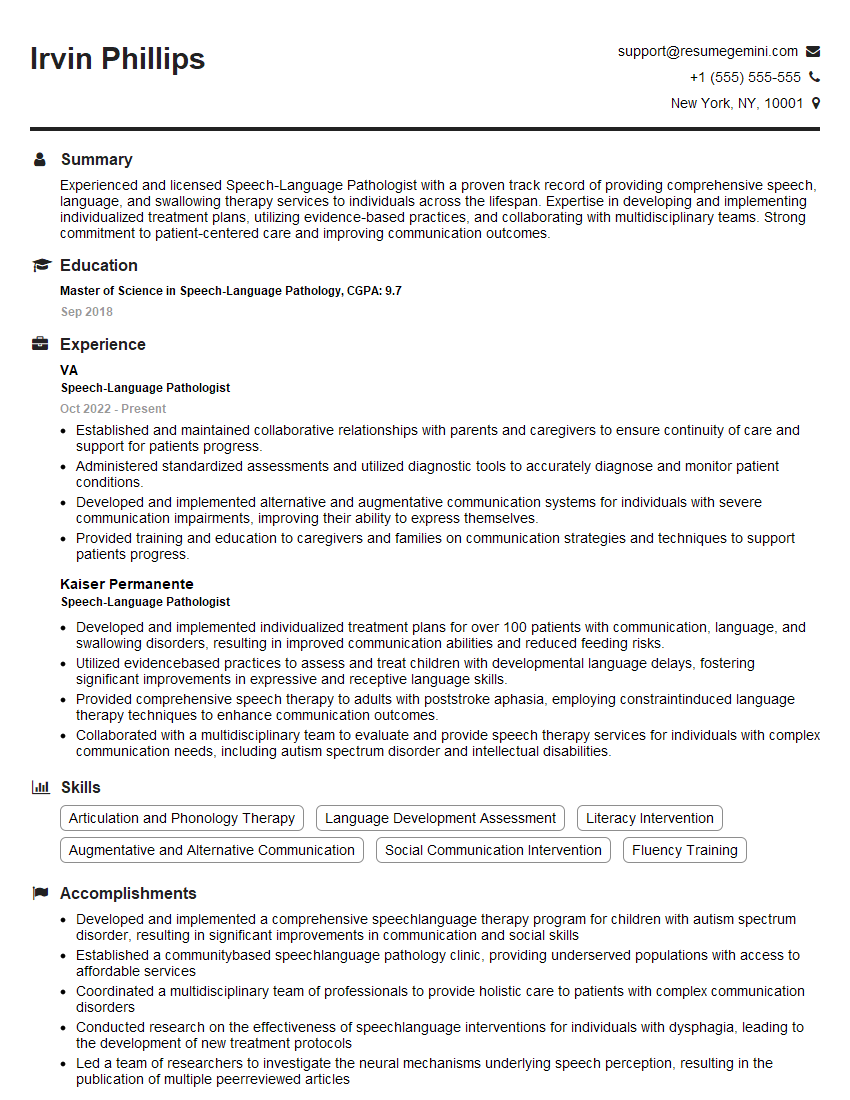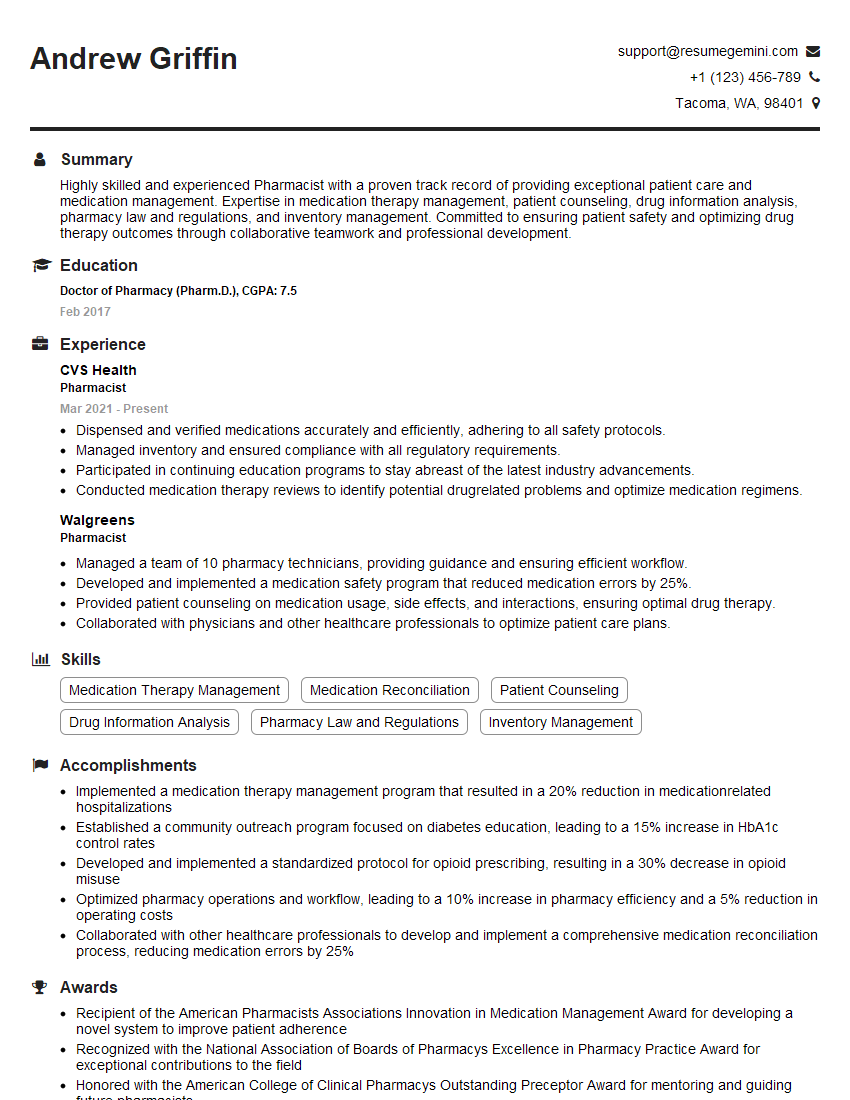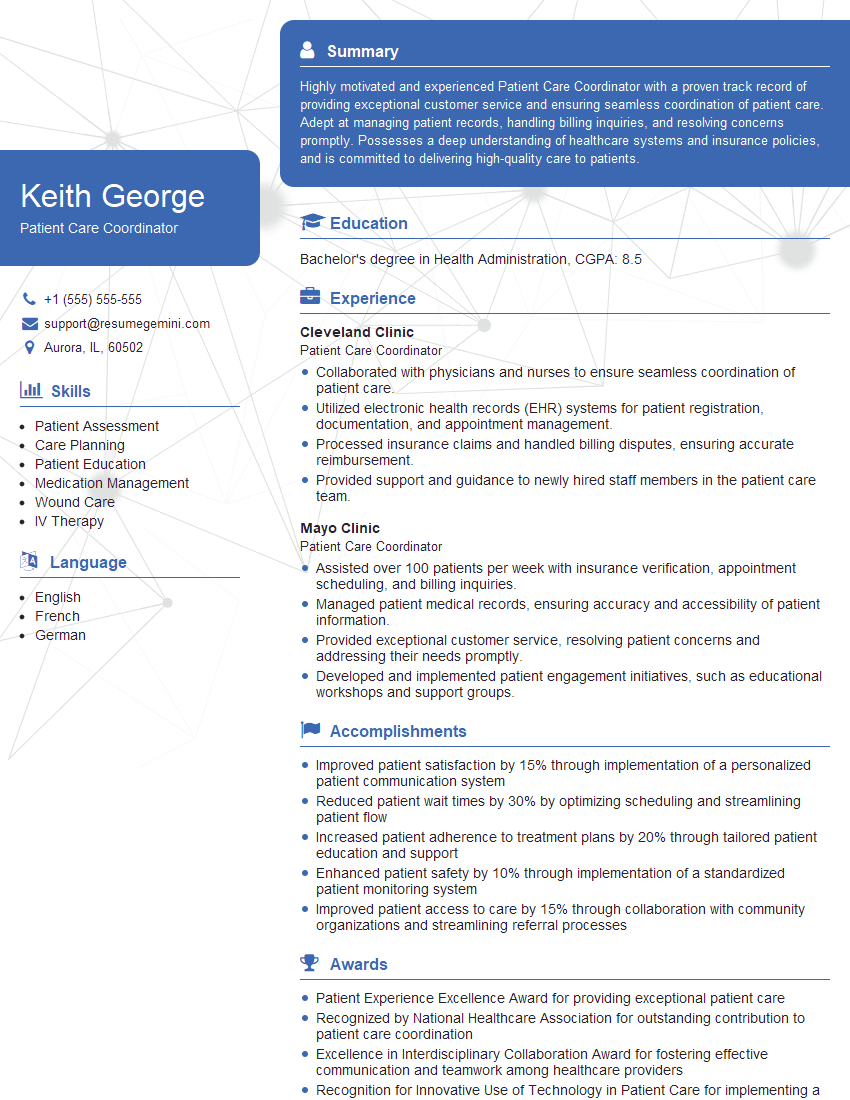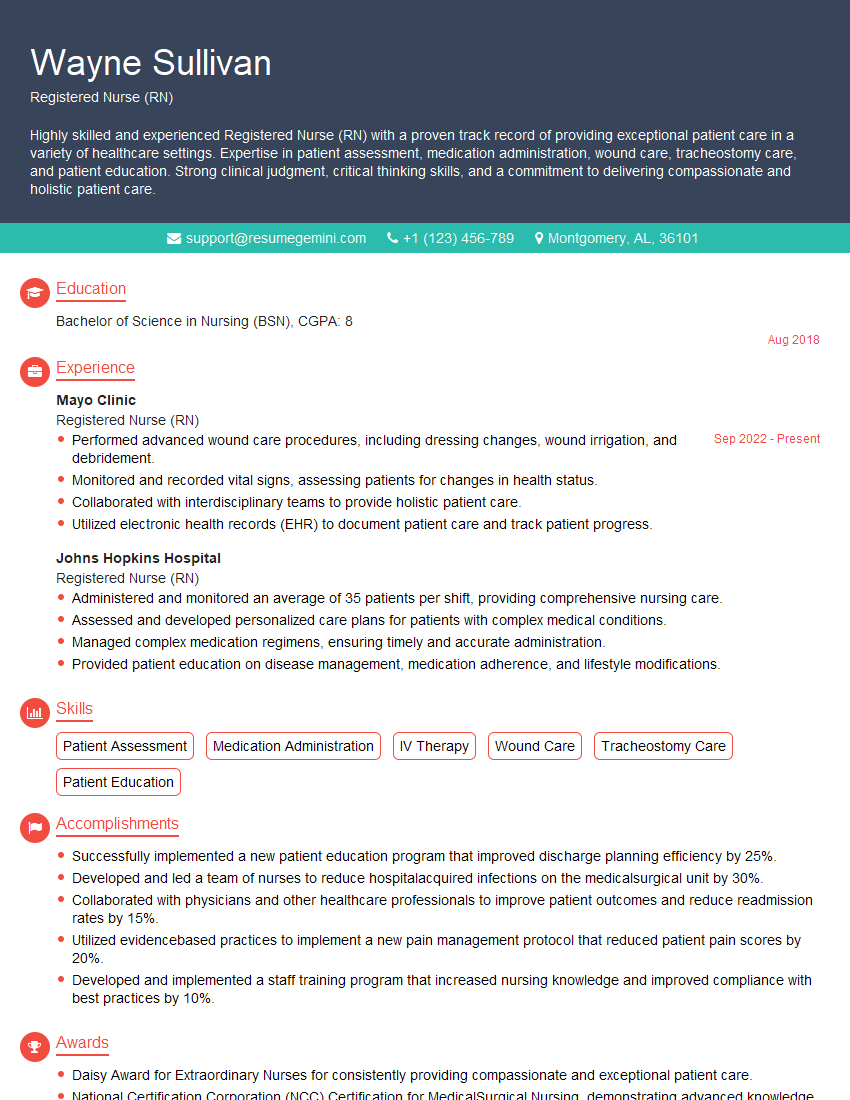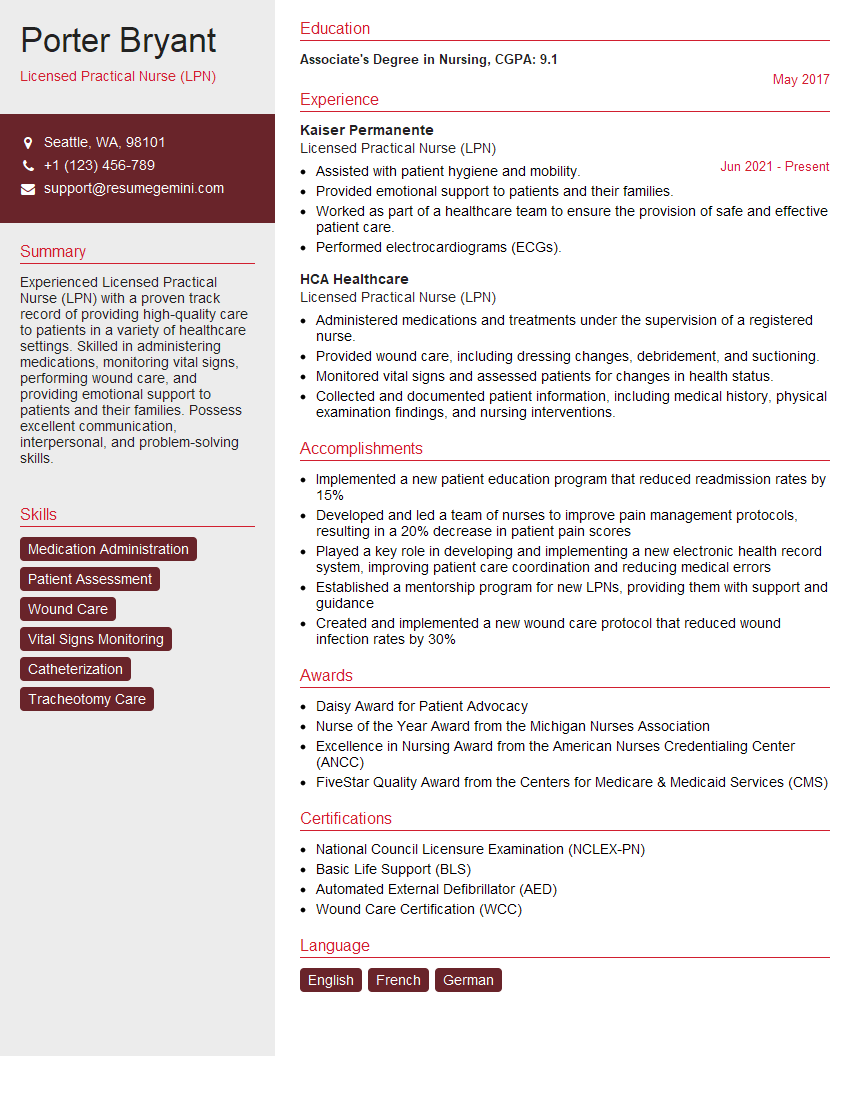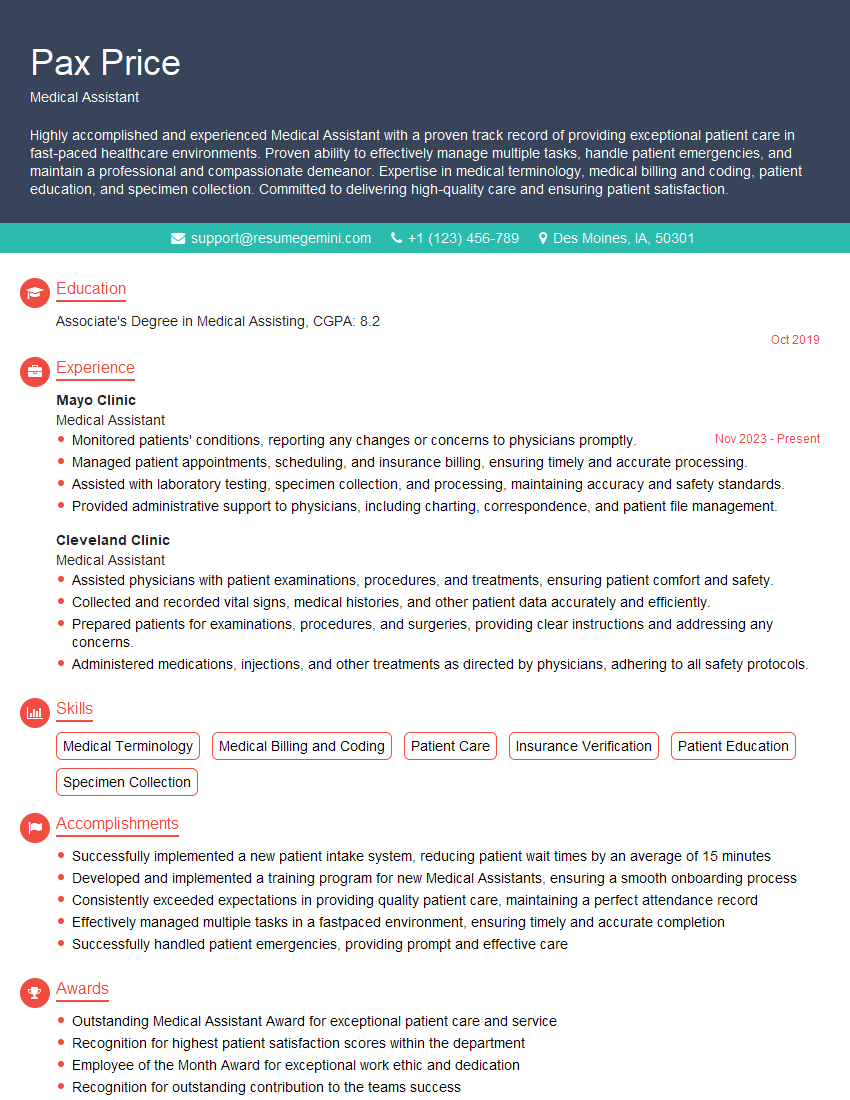Unlock your full potential by mastering the most common Healthcare Team Collaboration interview questions. This blog offers a deep dive into the critical topics, ensuring you’re not only prepared to answer but to excel. With these insights, you’ll approach your interview with clarity and confidence.
Questions Asked in Healthcare Team Collaboration Interview
Q 1. Describe your experience fostering effective communication within a healthcare team.
Effective communication is the cornerstone of any successful healthcare team. My approach focuses on establishing clear communication channels, promoting active listening, and ensuring transparency. This involves utilizing various methods, adapting to individual team member preferences, and regularly evaluating communication effectiveness.
- Structured Communication Channels: I advocate for using a combination of methods such as regular team meetings, dedicated communication platforms (e.g., instant messaging for quick updates, email for formal documentation), and whiteboards for visual progress tracking.
- Active Listening and Feedback: I encourage active listening during discussions, promoting a safe environment where team members feel comfortable sharing their perspectives without interruption. Providing constructive feedback is crucial; I focus on ‘behavior, impact, and suggestion’ to offer specific and actionable guidance.
- Transparency and Information Sharing: I believe in keeping all team members informed about patient progress, upcoming procedures, and potential challenges. This fosters trust and enables proactive problem-solving. Using a shared, secure platform for patient information updates is key.
For example, in my previous role, I implemented a daily ‘huddle’ system where the team briefly discussed critical patient cases, ensuring everyone was on the same page and any potential roadblocks could be addressed proactively.
Q 2. How do you handle conflict resolution within a multidisciplinary team setting?
Conflict is inevitable in a multidisciplinary team, but how it’s managed determines success. My approach involves identifying the root cause, facilitating open discussion, and finding collaborative solutions. I don’t shy away from addressing issues directly but prioritize respect and understanding.
- Identify the Root Cause: The first step is to understand the underlying reasons for the conflict. Is it a difference in opinion, miscommunication, or a clash of personalities? Neutral facilitation helps unearth these issues.
- Facilitate Open Discussion: Creating a safe and respectful space for all team members to express their perspectives is vital. Active listening ensures every voice is heard and understood. This often involves setting ground rules for respectful communication.
- Collaborative Problem Solving: Once the issues are understood, we work together to find mutually acceptable solutions. This might involve brainstorming, compromising, or mediating between differing opinions. Focus should always be on patient well-being.
- Document and Follow Up: After a resolution is reached, it’s crucial to document the agreement and follow up to ensure the solution is implemented and effective. This prevents recurring conflicts.
For instance, I once mediated a disagreement between a nurse and a physician regarding a patient’s treatment plan. By facilitating open communication, we uncovered differing interpretations of the patient’s medical history, which led to a revised and more effective treatment strategy.
Q 3. Explain your approach to building consensus amongst team members with differing opinions.
Building consensus involves respecting diverse viewpoints, fostering open dialogue, and finding common ground. My approach prioritizes understanding individual perspectives, identifying shared goals, and constructing solutions that address everyone’s concerns.
- Understand Perspectives: Begin by ensuring every team member has a chance to fully explain their viewpoint. Use active listening techniques to ensure a deep understanding of individual reasons and rationale.
- Identify Shared Goals: Focus on the overarching goals of the team and how each proposed solution aligns with these objectives. This helps to refocus discussions on outcomes rather than individual preferences.
- Collaborative Solution Building: Facilitate a brainstorming session to generate a range of potential solutions. Encourage a collaborative approach where each member contributes ideas and evaluates options based on their feasibility and impact.
- Decision-Making Process: Use a structured approach for decision-making, such as a weighted scoring system or voting, to ensure fairness and transparency. The process should be agreed upon beforehand.
In one situation, our team was debating the implementation of a new patient monitoring system. By facilitating a collaborative process, we were able to identify shared concerns about cost and usability, leading to a hybrid solution that addressed both points, achieving consensus and a successful implementation.
Q 4. Share an example where you successfully collaborated with colleagues to improve patient outcomes.
In my previous role, we experienced a high rate of post-operative complications for a specific surgical procedure. By collaborating with surgeons, nurses, and physiotherapists, we developed a new multidisciplinary care pathway that drastically reduced these complications.
- Problem Identification: We started by analyzing the data to pinpoint the root causes of the complications, identifying gaps in communication and care coordination.
- Collaborative Solution Development: A multidisciplinary team, including surgeons, nurses, physiotherapists, and pharmacists, was formed to brainstorm and develop a new care pathway. This involved reviewing existing protocols, identifying best practices, and incorporating new technologies.
- Implementation and Monitoring: The new pathway was implemented, and we closely monitored outcomes. Regular team meetings were held to review progress, address challenges, and make necessary adjustments.
- Results: The revised pathway led to a significant reduction in post-operative complications, improved patient satisfaction, and shortened hospital stays. This success was a direct result of effective collaboration and commitment from all team members.
Q 5. How do you ensure all team members understand their roles and responsibilities?
Clearly defining roles and responsibilities is crucial for efficient team functioning. My approach combines formal documentation with ongoing communication and training.
- Formal Role Descriptions: I ensure that each team member has a clear, written job description outlining their responsibilities, reporting lines, and key performance indicators. This should be easily accessible to all team members.
- Team Meetings and Communication: Regular team meetings provide opportunities to clarify roles, discuss challenges, and ensure everyone understands their contributions to the overall team goals.
- Training and Onboarding: Comprehensive training and onboarding are essential for new team members to understand their roles and responsibilities effectively. This also includes ongoing professional development opportunities.
- Open Communication Channels: Establishing open communication channels allows team members to ask questions, seek clarification, and address any uncertainties about their roles.
For instance, I developed a comprehensive training program for our new nursing staff that included a detailed overview of their roles, responsibilities, and team dynamics, helping them quickly integrate and perform effectively.
Q 6. Describe your experience using technology to enhance team collaboration (e.g., EHR, communication tools).
Technology plays a vital role in enhancing healthcare team collaboration. I have extensive experience leveraging Electronic Health Records (EHRs) and various communication tools to streamline workflows and improve communication.
- EHR Systems: I’m proficient in using EHR systems to share patient information, track progress, and ensure consistent data accessibility across the team. This minimizes redundancy and improves data accuracy. I’m also familiar with various EHR systems and can adapt my approach based on the specific system being used.
- Communication Platforms: Utilizing secure messaging platforms, video conferencing tools, and project management software can significantly enhance communication, especially in busy environments. This allows for rapid information exchange, efficient scheduling of meetings, and better collaboration on shared documents.
- Data Analytics: EHR data provides valuable insights that can inform decision-making and improve team performance. I’m experienced in analyzing EHR data to identify trends, areas for improvement, and measure the effectiveness of interventions.
In a previous role, I helped implement a secure messaging platform that reduced reliance on phone calls and pagers, improving response times and allowing for more efficient communication between team members.
Q 7. How do you manage time effectively within a busy healthcare team environment?
Time management in healthcare is critical. My approach involves prioritizing tasks, utilizing time-blocking techniques, and leveraging technology to optimize workflows.
- Prioritization: I utilize frameworks like the Eisenhower Matrix (urgent/important) to prioritize tasks, focusing on high-impact activities that directly contribute to patient care. This ensures that the most critical tasks are addressed promptly.
- Time Blocking: I schedule specific time slots for different tasks and meetings to create a structured workflow. This minimizes interruptions and maximizes productivity. I also include buffer time for unexpected events.
- Technology and Automation: Utilizing technology, such as EHR systems and automated reminders, can streamline workflows, reduce administrative burden, and free up time for patient care.
- Delegation: Effectively delegating tasks to team members based on their skills and availability ensures efficient use of everyone’s time.
- Regular Review and Adjustment: I regularly review my schedule and make adjustments as needed, adapting to changes in workload and priorities. This allows for flexibility and responsiveness in a dynamic environment.
For instance, by implementing a standardized scheduling system and leveraging technology for routine tasks, I was able to significantly improve efficiency and free up more time for direct patient interaction within my team.
Q 8. How do you delegate tasks effectively and provide appropriate support to team members?
Effective delegation isn’t just about assigning tasks; it’s about empowering team members to succeed. I begin by clearly defining the task, including the desired outcome, deadlines, and necessary resources. I then assess each team member’s skills and experience to match the task with the right person. This ensures both efficiency and development opportunities. Crucially, I provide appropriate support—this could be access to training, mentoring, or simply regular check-ins to address any challenges. I view my role as a facilitator, not a micromanager.
For example, when implementing a new electronic health record system, I wouldn’t simply assign tasks like ‘learn the new system’. Instead, I’d break down the training into manageable modules, assign them based on individual roles and experience levels (e.g., nurses focused on medication charting, doctors on clinical documentation), and schedule regular support sessions with IT staff and senior clinicians. This structured approach ensures everyone feels supported and contributes effectively.
Q 9. Describe your experience with interprofessional collaboration. Give a specific example.
Interprofessional collaboration is vital in healthcare. My experience includes working on a multidisciplinary team managing a complex patient case involving a stroke victim. The team included physicians, nurses, physical therapists, occupational therapists, speech-language pathologists, and social workers.
Specifically, a patient presented with significant swallowing difficulties (dysphagia) post-stroke. The speech-language pathologist conducted a thorough assessment, detailing the type and severity of the dysphagia. This information was then crucial for the nursing staff to adapt feeding strategies, preventing aspiration pneumonia. The occupational therapist focused on improving upper limb function to aid in independent feeding, while the physical therapist addressed mobility issues. Regular team meetings, using a shared electronic health record, enabled seamless communication and coordinated care. Through this collaboration, we successfully improved the patient’s swallowing function, mobility, and overall quality of life – a better outcome than if each discipline worked in isolation.
Q 10. How do you identify and address communication barriers within a team?
Communication barriers are common in healthcare teams. I actively identify them through observation, feedback mechanisms (like regular team meetings and anonymous surveys), and direct communication with team members. Common barriers include jargon, differing communication styles, information overload, and lack of access to information.
To address these, I implement strategies like using clear and concise language, actively listening, using visual aids during presentations, establishing clear communication protocols (e.g., using specific channels for different types of communication), and ensuring that all team members have access to relevant information through shared electronic platforms. For example, introducing a standardized reporting system for critical incidents ensures everyone is informed and reduces ambiguity.
Q 11. What strategies do you employ to promote a positive and supportive team environment?
Building a positive and supportive team environment is paramount. I achieve this by fostering open communication, mutual respect, and trust. This includes actively promoting teamwork, celebrating successes, and acknowledging individual contributions. I also focus on providing regular feedback, both positive and constructive, using a supportive and non-judgmental approach.
Furthermore, I encourage team-building activities (e.g., informal team lunches, participation in professional development workshops) to strengthen relationships and create a sense of camaraderie. Addressing conflict constructively and fairly is also crucial—facilitating open dialogue and finding solutions that work for everyone is essential.
Q 12. How do you contribute to a culture of continuous learning and improvement within your team?
Continuous learning and improvement are vital. I contribute to this by encouraging team members to attend relevant conferences and workshops, actively participate in continuing education programs, and share knowledge through journal clubs or case studies. I also champion evidence-based practice, encouraging the team to regularly evaluate existing protocols and implement changes based on new research or best practices.
Implementing a system for collecting and analyzing feedback on processes is critical. This data informs future improvements, and helps ensure our team is providing the highest quality of care. For example, we might track patient satisfaction scores, identify areas for improvement, and implement changes accordingly. It is a continuous cycle of learning and adaptation.
Q 13. Explain your understanding of different team dynamics and how you adapt to them.
Understanding team dynamics is essential for effective leadership. Teams can be highly collaborative and efficient, or experience conflicts and inefficiencies. Factors like team size, member personalities, communication styles, and leadership approaches all contribute. I use various tools, such as personality assessments (not as a definitive label but to enhance self-awareness) and team-building exercises, to understand my team’s dynamics.
My approach adapts to the specific team. For example, with a highly independent team, I might provide more autonomy and less oversight. With a less experienced team, I’d provide more structured support and mentorship. In situations of conflict, I intervene promptly, encouraging open communication and finding mutually acceptable solutions. Ultimately, the goal is to create a harmonious and high-performing team, recognizing and respecting the unique contributions of each member.
Q 14. How do you ensure patient privacy and confidentiality while collaborating within a team?
Patient privacy and confidentiality are paramount. Within a team, I ensure compliance with HIPAA regulations and any other relevant privacy laws. This includes educating team members on privacy best practices, limiting access to patient information to only those who have a legitimate need to know, using secure communication channels, and properly disposing of any sensitive documents.
When sharing information, I only use the minimum necessary information required for effective collaboration. I always emphasize the importance of securing electronic devices and adhering to password protection protocols. Regular training and reminders about privacy policies and procedures are crucial to maintaining a culture of responsible information handling.
Q 15. How do you provide constructive feedback to team members to improve their performance?
Providing constructive feedback is crucial for team growth. It’s not about criticism, but about helping individuals improve their performance and contribute more effectively. My approach focuses on the Situation-Behavior-Impact (SBI) model. I start by describing the specific situation where the behavior occurred, then clearly outline the behavior itself, avoiding generalizations or personal attacks. Finally, I explain the impact of that behavior on the team, the patient, or the overall project. This ensures the feedback is objective and actionable.
For example, instead of saying “You’re disorganized,” I might say, “During the morning rounds on Tuesday (Situation), I noticed the patient charts weren’t properly updated (Behavior), which delayed the attending physician’s review and potentially impacted patient care (Impact). Perhaps we could discuss strategies for improving your workflow?” I always conclude with suggestions for improvement and offer my support.
Career Expert Tips:
- Ace those interviews! Prepare effectively by reviewing the Top 50 Most Common Interview Questions on ResumeGemini.
- Navigate your job search with confidence! Explore a wide range of Career Tips on ResumeGemini. Learn about common challenges and recommendations to overcome them.
- Craft the perfect resume! Master the Art of Resume Writing with ResumeGemini’s guide. Showcase your unique qualifications and achievements effectively.
- Don’t miss out on holiday savings! Build your dream resume with ResumeGemini’s ATS optimized templates.
Q 16. Describe a situation where you had to negotiate priorities or resources within a team.
In a recent project involving the implementation of a new electronic health record (EHR) system, our team faced resource constraints. We had limited training time and a tight deadline. Negotiation was key. I facilitated a meeting where each team member outlined their priorities and the resources they needed. We used a collaborative prioritization matrix, ranking tasks based on urgency and impact. Some tasks, deemed less critical in the initial phase, were postponed. This involved actively listening to each team member’s concerns, identifying common ground, and making compromises. For example, the nurses prioritized learning the medication ordering module first, while the physicians focused on patient charting. We allocated training resources accordingly and achieved a successful launch, albeit with some minor initial adjustments.
Q 17. How do you handle situations where a team member is not meeting expectations?
Addressing underperformance requires a sensitive yet firm approach. I begin by having a private, informal conversation with the team member. I focus on specific instances of unmet expectations, using data and observations to support my points, similar to the SBI method mentioned earlier. I explore potential underlying reasons for the underperformance, such as lack of training, unclear expectations, or personal issues. Providing additional support or resources is often part of the solution, like offering mentorship or additional training. If the issue persists, I’d follow the organization’s performance improvement plan, involving progressive discipline if necessary. The goal is always to support the team member’s growth, while protecting the team’s overall performance and patient safety.
Q 18. Describe your experience with change management within a healthcare team.
Change management is vital in healthcare, where new technologies, policies, and workflows are constantly introduced. My experience involves actively participating in the planning and execution phases of change initiatives. I believe in fostering open communication and transparency. During the implementation of a new telehealth system, for example, I held regular team meetings to address concerns, provide training, and celebrate small successes. We also created a feedback mechanism to address any challenges promptly. Employing the Lewin’s Change Management model – Unfreeze, Change, Refreeze – proved effective. We first addressed the team’s anxieties about the new system (Unfreeze), then provided comprehensive training and support during the implementation (Change), and finally established new processes and workflows to solidify the changes (Refreeze). This approach ensured a smoother transition and minimized disruption to patient care.
Q 19. How do you balance individual goals with the overall team goals?
Balancing individual and team goals requires clear communication and shared understanding. It’s essential to create a team environment where individual contributions align with the overall objectives. We use a collaborative goal-setting process, ensuring individual goals are aligned with and support team goals. For example, if a team’s goal is to reduce patient wait times, an individual nurse’s goal might be to improve the efficiency of their patient intake process. Regular check-ins and progress reports allow us to monitor individual performance and ensure it’s contributing to the team’s success. Open communication allows for adjustments and ensures everyone feels valued and part of a larger purpose.
Q 20. How do you measure the success of team collaboration efforts?
Measuring the success of team collaboration involves both qualitative and quantitative metrics. Quantifiable measures might include improvements in patient satisfaction scores, reduced wait times, improved efficiency metrics, or a decrease in medical errors. Qualitative measures include assessing team morale, observing improved communication and collaboration, analyzing feedback from team members and patients, and evaluating the overall effectiveness of the team’s processes. We regularly review these metrics, using data-driven insights to refine our approach and improve team performance. For instance, a reduction in patient readmission rates, directly linked to improved care coordination within the team, would be a significant indicator of successful collaboration.
Q 21. Describe a time you had to adapt your communication style to work effectively with diverse team members.
Our team is comprised of individuals from diverse cultural and professional backgrounds. Adapting my communication style is crucial for effective collaboration. I ensure clear and concise communication, avoiding jargon and adapting my language to suit different levels of understanding. I’m mindful of non-verbal cues, actively listening, and encouraging open discussion. For example, I noticed a team member from another country was hesitant to speak up in meetings. I made a point to engage them directly, asking for their input and making them feel comfortable sharing their ideas. I also adjusted my communication style to be more direct and less indirect in meetings with colleagues from cultures known to value a more direct communication style. This demonstrates respect and understanding, fostering a more inclusive and productive work environment.
Q 22. Explain how you handle stressful situations that involve team collaboration.
Stressful situations in healthcare team collaboration are inevitable. My approach is multifaceted and focuses on proactive strategies and reactive problem-solving. I start by acknowledging the stress, both my own and my team members’. Open communication is key; I create a safe space for team members to voice concerns and anxieties without judgment. This often involves a brief team huddle to assess the situation and identify the core stressors. Then, I utilize a structured approach, prioritizing tasks based on urgency and impact. This might involve delegating tasks effectively, leveraging individual strengths, and ensuring everyone understands their roles and responsibilities. For example, during a code blue situation, my role is to ensure clear communication between the medical team, nursing staff, and support services. Clear delegation, calm leadership, and consistent updates are crucial in mitigating stress and ensuring patient safety. If the stress is persistent, I advocate for debriefing sessions following the event to process emotions and learn from the experience. This ensures both immediate stress management and continuous improvement for future situations.
Q 23. How do you contribute to a culture of safety and quality improvement within your team?
Cultivating a culture of safety and quality improvement requires consistent effort and a commitment to proactive risk management. I actively participate in regular safety huddles, contributing to the identification and mitigation of potential hazards. I champion the use of root cause analysis (RCA) when incidents occur, ensuring that we learn from mistakes rather than simply addressing symptoms. This often involves using tools like fishbone diagrams to visualize contributing factors. Furthermore, I encourage a ‘Just Culture,’ where individuals feel comfortable reporting errors without fear of blame, fostering a learning environment. For instance, I recently implemented a system where staff could anonymously submit near-miss reports, allowing us to address potential problems before they lead to actual patient harm. I also actively seek feedback from my colleagues, implementing suggestions to improve workflows and communication processes. Continuous education and training are essential components of maintaining a high standard of care, so I proactively seek out opportunities for professional development and share this knowledge with my team.
Q 24. How do you utilize data to inform team decisions and improve processes?
Data is essential for evidence-based decision-making in healthcare. My approach involves using data to identify trends, analyze performance, and improve processes. For example, if we notice a high rate of medication errors on a particular unit, I would use EHR data to analyze the frequency, types of errors, and contributing factors. This might involve looking at medication administration times, staffing levels, and nurse-to-patient ratios. We can then use this data to design interventions, such as implementing a new medication reconciliation process or providing additional training. Similarly, patient satisfaction surveys provide valuable qualitative data that complements quantitative data from the EHR. By combining these data sources, we can gain a holistic understanding of our team’s performance and identify areas for improvement. I am proficient in using statistical software to analyze data and create visually appealing reports that are easily understood by the team. This allows for informed decision-making, resource allocation, and ultimately, improved patient outcomes.
Q 25. How proficient are you in using electronic health records (EHR) for team communication and collaboration?
I am highly proficient in using electronic health records (EHRs) for team communication and collaboration. My experience spans several EHR systems, including Epic and Cerner. I utilize EHR functionalities such as secure messaging, progress notes, and order entry for seamless communication among team members. For example, I routinely use secure messaging to communicate with specialists, consultants, and other healthcare professionals to ensure timely exchange of critical patient information. I also utilize the EHR’s charting functions to maintain comprehensive and easily accessible patient records, which is critical for effective handoffs and continuity of care. I am familiar with utilizing the built-in communication tools within the EHR to facilitate quick and efficient updates regarding changes in patient status or treatment plans. Beyond the basic functionalities, I’m comfortable with using advanced features such as clinical documentation improvement tools and reporting features to track key performance indicators and patient outcomes.
Q 26. Describe your experience with using project management tools for healthcare team projects.
I have extensive experience using project management tools for healthcare team projects. My preferred tools include Asana and Trello, due to their intuitive interfaces and collaborative features. I leverage these tools to manage tasks, track progress, and ensure timely completion of projects. For example, when implementing a new clinical guideline, I utilized Trello to create a Kanban board, defining individual tasks, assigning responsibilities, and monitoring deadlines. The visual nature of the board allowed for easy tracking of the project’s progress, fostering accountability and promoting team transparency. I use these tools to establish clear communication channels, ensuring all team members are updated on project milestones and potential roadblocks. The ability to integrate these tools with other platforms, such as Google Calendar and email, further streamlines workflows and enhances team coordination.
Q 27. How do you ensure that team members are aware of and comply with relevant regulations and policies?
Ensuring team compliance with regulations and policies is paramount. My approach is proactive and multi-pronged. First, I ensure that all team members receive initial training on relevant policies and procedures upon joining the team. This includes HIPAA compliance, infection control protocols, and any other relevant regulations specific to our healthcare setting. I utilize a variety of training methods, including online modules, in-person workshops, and regularly scheduled team meetings dedicated to reviewing key policies. Secondly, I implement regular compliance checks and audits to monitor adherence. This may involve reviewing documentation, observing team workflows, and conducting regular quizzes or assessments. I also actively seek feedback from the team to identify any challenges in understanding or implementing the policies. Finally, any non-compliance is addressed swiftly and constructively, providing education and support to rectify the situation. This approach ensures a culture of compliance and reduces the risk of violations. I also emphasize the importance of reporting any potential compliance concerns immediately, fostering a culture of openness and accountability.
Key Topics to Learn for Healthcare Team Collaboration Interview
- Communication Strategies: Mastering effective verbal, written, and non-verbal communication techniques within a healthcare setting. Consider the nuances of communicating with patients, colleagues, and superiors.
- Conflict Resolution & Negotiation: Explore practical strategies for resolving disagreements and navigating conflicts within diverse healthcare teams. Develop approaches for reaching mutually beneficial solutions.
- Team Dynamics & Roles: Understand the dynamics of various healthcare team structures (e.g., multidisciplinary teams). Analyze the roles and responsibilities of different team members and how they contribute to patient care.
- Interprofessional Collaboration: Focus on the principles and practicalities of effective collaboration across professions (doctors, nurses, therapists, etc.). Discuss examples of successful interprofessional teamwork and their impact on patient outcomes.
- Patient-Centered Care & Shared Decision-Making: Learn how to actively involve patients in their care plans through effective communication and shared decision-making processes. Understand the importance of patient autonomy and preferences.
- Leadership & Followership in Teams: Explore effective leadership styles and the importance of positive followership within healthcare teams. Understand how to contribute to a collaborative and supportive team environment.
- Technology & Collaboration Tools: Discuss the role of technology in facilitating communication and collaboration within healthcare teams (e.g., electronic health records, telehealth platforms). Analyze the benefits and challenges of using such technologies.
- Ethical Considerations: Explore ethical dilemmas and decision-making processes within healthcare teams. Understand how to navigate complex situations while upholding professional ethics and patient well-being.
Next Steps
Mastering healthcare team collaboration is crucial for career advancement in today’s dynamic healthcare landscape. Demonstrating these skills significantly enhances your candidacy and opens doors to leadership roles and greater responsibilities. To maximize your job prospects, it’s essential to create a strong, ATS-friendly resume that effectively showcases your qualifications. We strongly encourage you to use ResumeGemini, a trusted resource for building professional resumes. ResumeGemini provides examples of resumes specifically tailored to highlight expertise in Healthcare Team Collaboration, helping you present yourself effectively to potential employers.
Explore more articles
Users Rating of Our Blogs
Share Your Experience
We value your feedback! Please rate our content and share your thoughts (optional).
What Readers Say About Our Blog
Hi, I have something for you and recorded a quick Loom video to show the kind of value I can bring to you.
Even if we don’t work together, I’m confident you’ll take away something valuable and learn a few new ideas.
Here’s the link: https://bit.ly/loom-video-daniel
Would love your thoughts after watching!
– Daniel
This was kind of a unique content I found around the specialized skills. Very helpful questions and good detailed answers.
Very Helpful blog, thank you Interviewgemini team.


